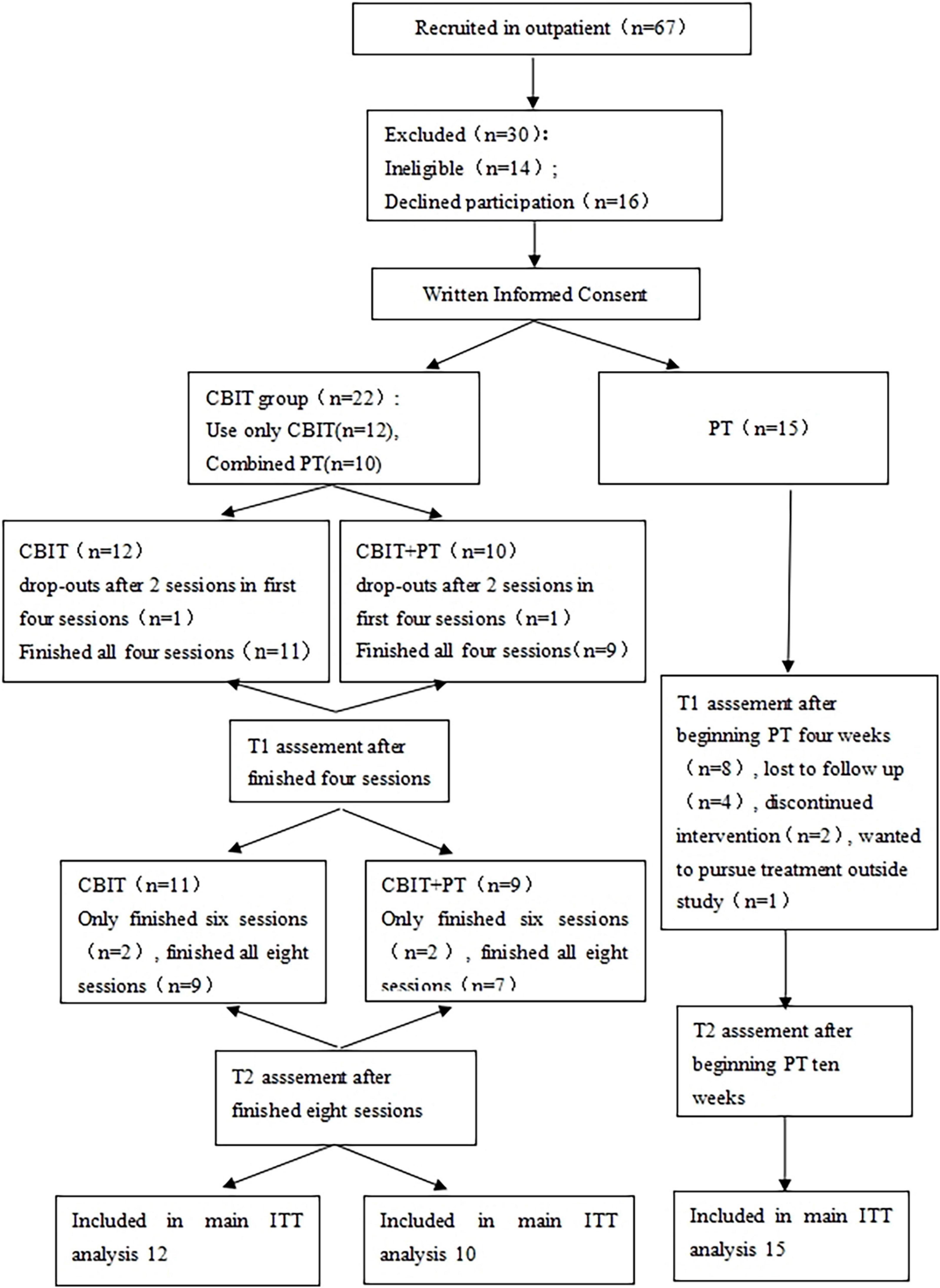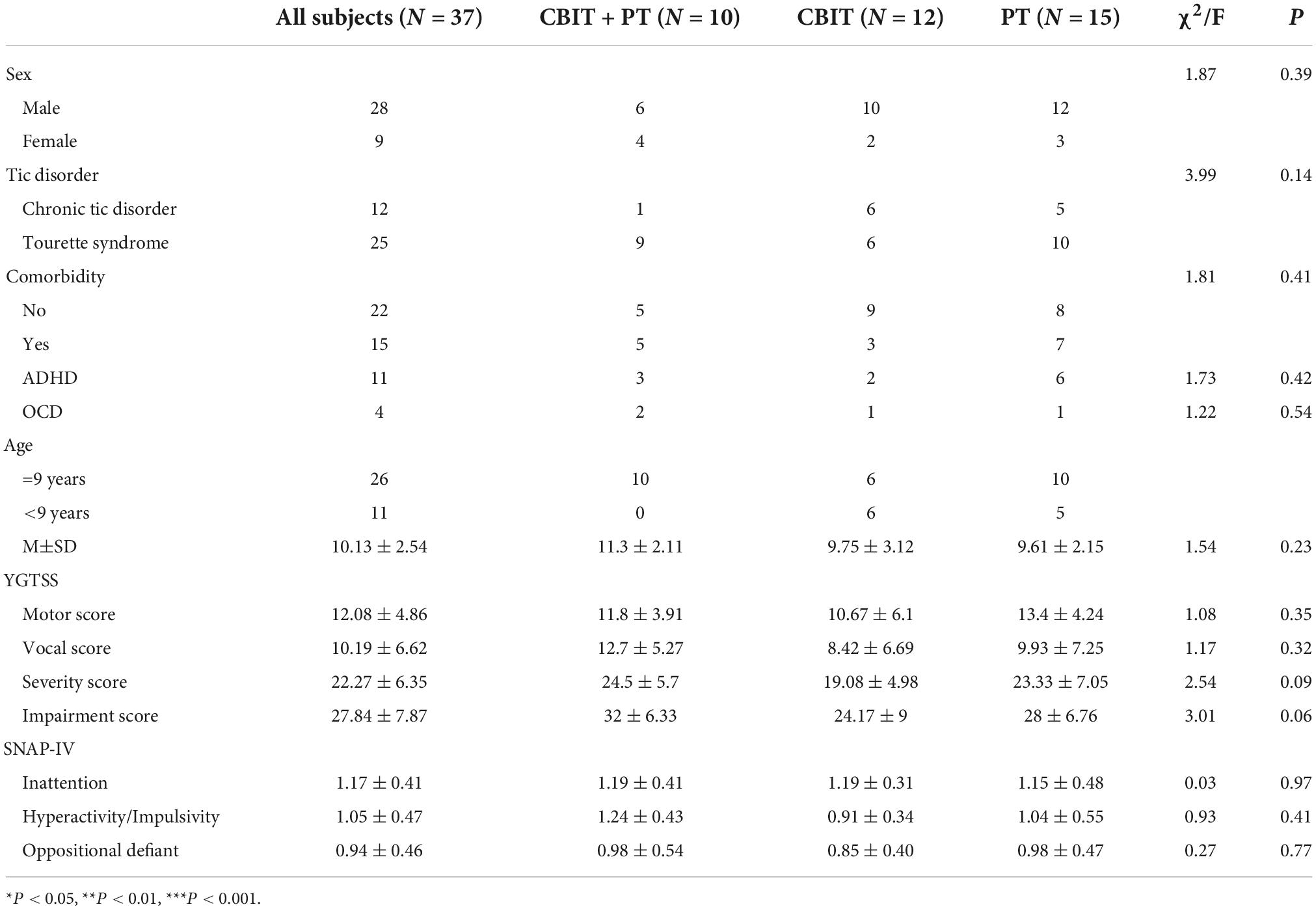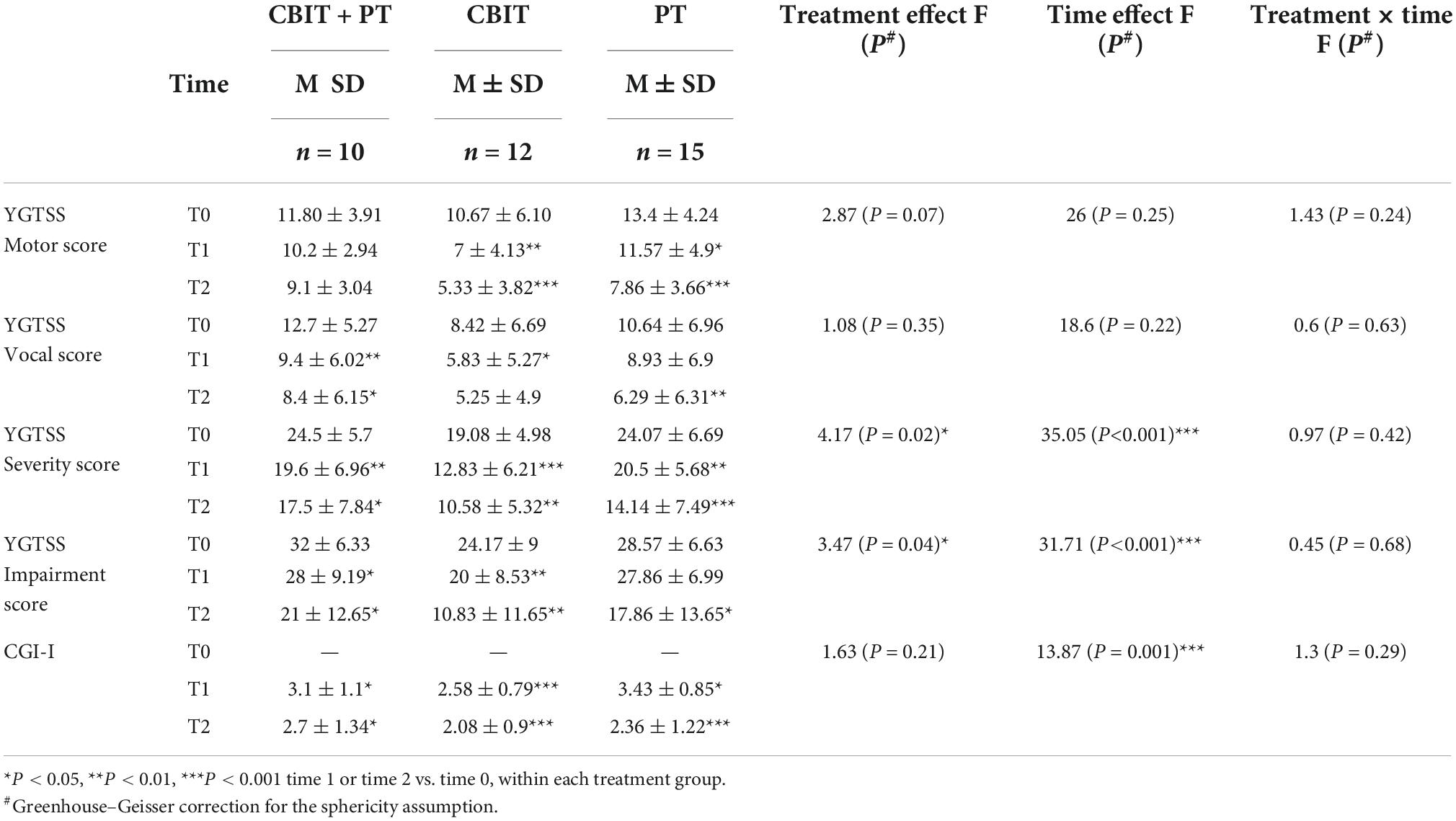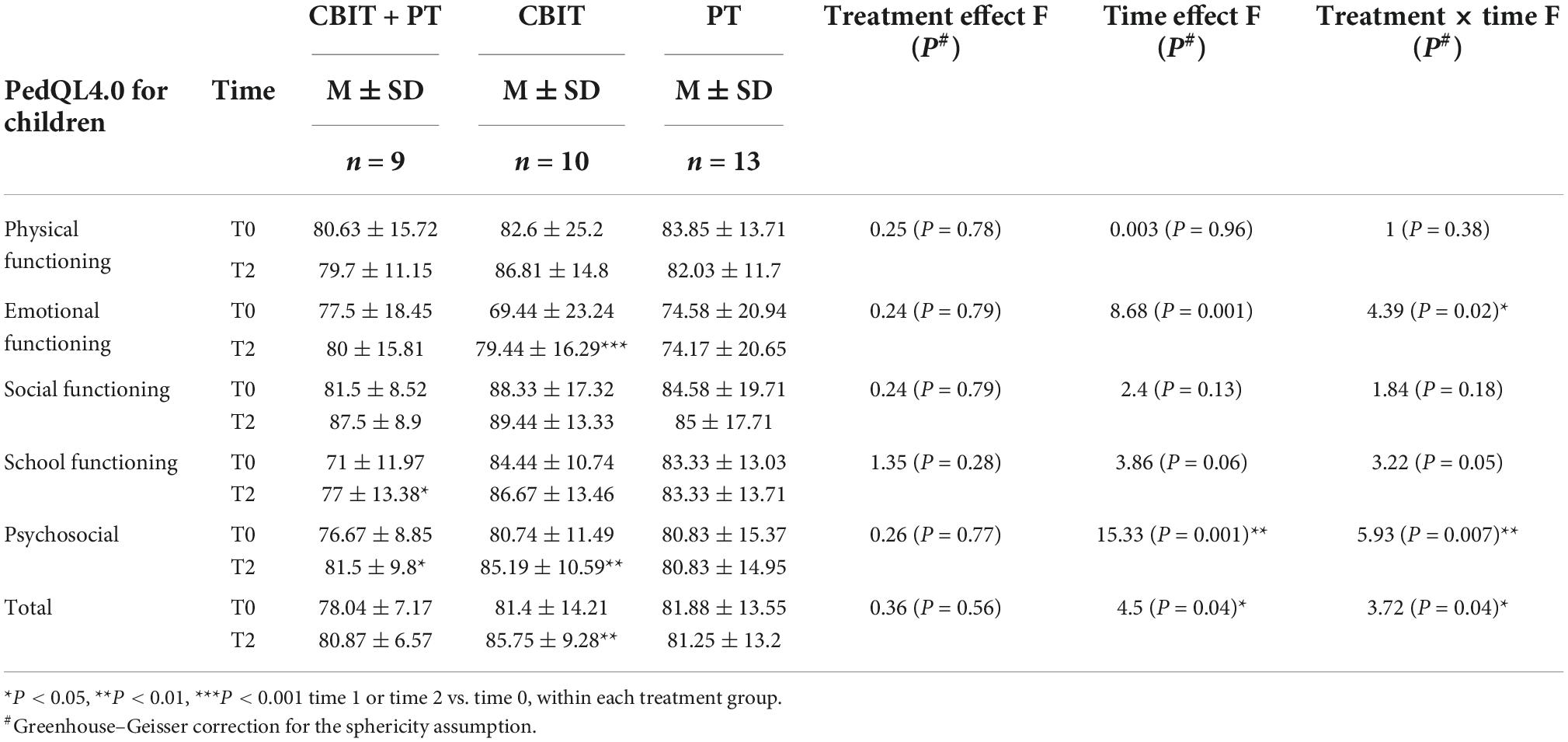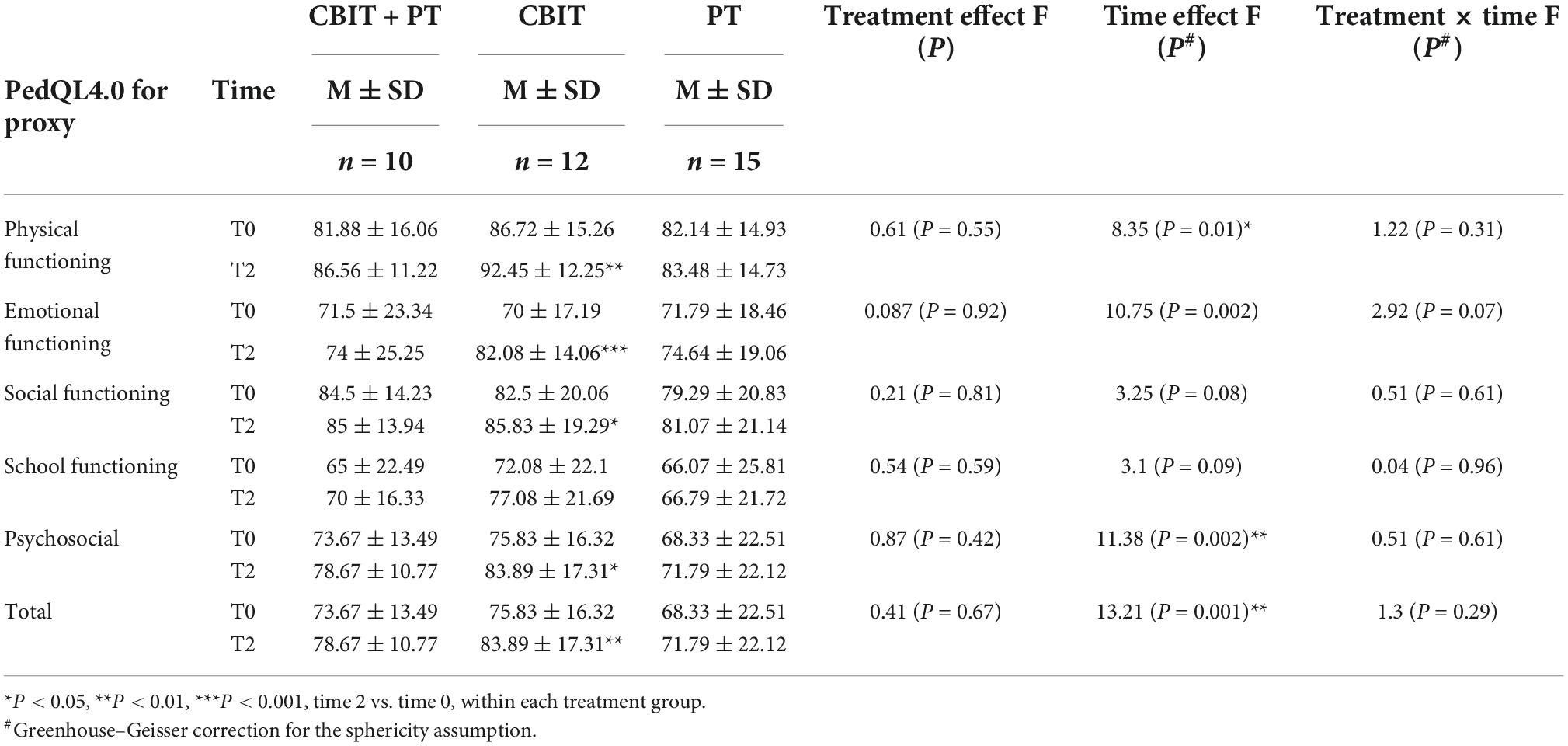- 1Department of Psychological Medicine, Children’s Hospital of Fudan University, Shanghai, China
- 2Shanghai Mental Health Center, Shanghai Jiao Tong University, Shanghai, China
- 3School of Medicine, Tongji University, Shanghai, China
Objective: To investigate the adaptability of Comprehensive Behavioral Intervention for Tics (CBIT) for a Chinese population, and evaluate the efficacy of combined CBIT and pharmacotherapy (CBIT + PT) compared to CBIT or pharmacotherapy (PT) alone for reducing tics and for improving the quality of life (QoL) in a sample of Chinese children with chronic tic disorders (CTD) and Tourette syndrome (TS).
Materials and methods: In this 10-week randomized controlled pilot trial, 37 outpatients aged between 6 and 16 years affected by TS and CTD were randomly assigned to receive CBIT (n = 22) or PT alone (n = 15). Considering the feasibility, the patients allocated to the CBIT treatment group could further choose whether to simultaneously take medicine voluntarily, resulting in a CBIT alone group (n = 12) and a CBIT + PT group (n = 10).
Results: At baseline, no significant difference was found between the three groups in the demographic and clinical characteristics (p > 0.05). All three groups showed a significant reduction in tic severity after treatment assessed by the Yale Global Tic Severity Scale (YGTSS) severity score [F(2,33) = 35.05, p < 0.001, ηp2 = 0.51], the score of the Clinical Global Impression scale for Improvement (CGI-I) [F(1,34) = 13.87, p = 0.001, ηp2 = 0.29], and YGTSS impairment score [F(2,33) = 31.71, p < 0.001, ηp2 = 0.48]. Significant interactions were found between the time-point and group in emotional functioning [F(2,29) = 4.39, p = 0.02, ηp2 = 0.23], psychosocial functioning [F(2,29) = 5.93, p = 0.007, ηp2 = 0.29], and total QoL score [F(1,34) = 3.72, p = 0.04, ηp2 = 0.20] of Pediatric Quality of Life Inventory (PedsQL 4.0) for children suggesting a significantly larger improvement in emotional functioning, psychosocial functioning, and total QoL score of the life quality in the CBIT group for children self-report. PedsQL for proxy report only showed a significant main effect of time-point in physical functioning [F(1,33) = 8.35, p = 0.01, ηp2 = 0.2], emotional functioning [F(1,33) = 10.75, p = 0.002, ηp2 = 0.25], psychosocial functioning [F(1,34) = 11.38, p = 0.002, ηp2 = 0.26], and total Qol score [F(1,34) = 13.21, p = 0.001, ηp2 = 0.29].
Conclusion: CBIT is probably effective in reducing tic severity in Chinese children with tic disorders. CBIT + PT may not be superior to CBIT alone in reducing tic severity and improving quality of life. CBIT alone showed advantages in improving quality of life over CBIT + PT and PT alone. CBIT might be an appropriate treatment option for patients with tic disorder in Chinese mainland.
Introduction
Tourette syndrome (TS) and chronic tic disorders (CTD) are neurodevelopmental disorders characterized by the presence of motor tics and/or vocal tics, and at least 1 motor or vocal tic should have lasted for 12 months (1). Typically, tics began at the age of 4–6 years, and the severity of tics is worst between 10 and 12 years and decreases naturally during adolescence and early adulthood (2). Common psychiatric comorbidities among individuals with TS/CTD include obsessive–compulsive disorder (OCD), attention deficit hyperactivity disorder (ADHD), anxiety disorders (AD), and affective disorders (3). Several studies have shown that in patients with TS and CTD, the quality of life (QoL) is impaired, and the presence of comorbidities is correlated with poorer perceived QoL (4, 5). For TS/CTD patients, behavioral therapy (BT) and pharmacotherapy (PT) showed efficacy in reducing tics. In the European clinical guidelines for TS, BT is recommended as the first-line treatment for tic disorders (2, 6).
Comprehensive Behavioral Intervention for Tics (CBIT) as the representative of BT for tic disorders has demonstrated success in reducing tics for children and adults (7–9). In clinical guidelines for the treatment of tic disorders, the American Academy of Neurology (AAN) suggested that CBIT should be offered as an initial treatment option in advance of other psychological interventions and to PT in clinics (10). The core component of CBIT is habit reversal training (HRT), including tic awareness, competing-response training, and social support. Awareness training, includes plenty of techniques that aim to increase awareness of tic happened and associated premonitory urges. Competing response training teaches the patient to do the opposite behavior when they notice the tic has happened or is about to happen. The competing response should apply for 1 min or until the urge to tic disappears and prevents tics from being occurred. Social support involves having a person remind the patient to use the competing response and acclaim the patient for doing the competing response correctly. In addition to HRT, CBIT also includes sessions of psychoeducation, function-based assessment and interventions, relaxation training, and relapse prevention plans (11).
Despite the AAN recommendations, there is still some debate about whether behavioral therapy should be chosen as a first-line option over PT (6), as PT is still generally used as first-line therapy for patients with complex tics (12). PT and BT alone have shown efficacy in tic disorders, e.g., in a recent network meta-analysis including 60 randomized controlled trials (RCTs) found antipsychotic drugs can significantly improve tic symptom score (SMD ranging from −12.32 to −3.20) compared with placebo (13). Another meta-analysis showed BT has a medium effect size (SMD = −0.43, 95% CI: −0.71, −0.16) compared with psychoeducation and supportive therapy (14).
To date, only one study has directly compared PT to behavior therapy in a sample of children and teenagers with CTD and TS, with results showing equal effects in reducing the severity of tic symptoms and improving QoL (15). Given this reality, the newly released European clinical guidelines for TS suggested testing a combination of BT and PT may yield additional treatment benefits (2). No studies have checked out the possible additive effects of combining CBIT and PT as we known.
In Chinese mainland, PT is the first-line treatment for TS or CTD (16), and behavior therapy has low availability. Nevertheless, behavior therapy has shown promise in the Chinese population. One study (17) adopted HRT to 40 children with a tic disorder and found HRT is effective in reducing tics. But no studies have assessed the efficacy of CBIT in Chinese mainland.
The aim of the current study was to investigate the adaptability of CBIT in the Chinese population and evaluate whether CBIT + PT for tics would prove superior to CBIT and PT alone in reducing tics and improving the QoL in a sample of Chinese children and adolescents with TS and CTD.
Materials and methods
Study design
This study was conducted in the outpatient clinics in the Department of Psychological Medicine of the Children’s Hospital of Fudan University. Patients were firstly randomized to receive one of two main treatments: CBIT or PT alone. Patients, allocated to CBIT were given the choice to take medicine voluntarily, who decided the choice before any intervention began and knew the grouping scheme at the beginning of the informed consent stage of the project. Thus, it resulted in three groups: CBIT alone (CBIT), CBIT plus pharmacotherapy (CBIT + PT) and pharmacotherapy alone (PT).
The study received approval from the local ethics committee (Approval Number: Children’s Hospital of Fudan University, 2018-290). Before enrollment, a phone screening was conducted, in which the purpose and overall process of the study were described. For eligible participants, a face-to-face visit was held, at which time informed consent/assent was obtained from parents/children, a clinical interview was performed, a baseline assessment was conducted, and randomization occurred.
Participants
Eligible participants were patients aged 6–16 years with a DSM-5 diagnosis of TS or CTD as given by an experienced child deputy-chief psychiatrist. Inclusion criteria were as follows: Yale Global Tic Severity Scale (YGTSS) > 13 (18). Exclusion criteria included the diagnosis of intellectual disability, learning disorder, and autism spectrum disorder, >4 sessions of habit reversal training or other behavioral treatment for tics, ADHD or OCD diagnoses requiring immediate treatment or change in the current treatment regimen, and unwillingness to participate in the study.
Children who were taking anti-tic medication before enrollment were interviewed, if they are willing to participate in this study. They need to go through a 4 weeks drug washout period before the randomization and the baseline assessment without affecting their condition of tics after the consent of their psychiatrist in charge. Other than the medication prescribed as part of the study, no new medications was started for tics or comorbid conditions during the study.
Sample size determination and subjects allocation to groups
The sample size in this study was calculated by the GPower3.1 statistical software (19). The main setting parameters were: power = 0.8, alpha = 0.05, effect size f = 0.25 (20), symmetry correlation coefficient ρ = 0.5, and non-spherical correction coefficient ε = 1. This study has three treatment groups (CBIT group, PT group, and CBIT + PT group), a total of three assessment levels (baseline, 4 weeks of treatment, and 10 weeks of treatment), using a mixed factors design, the power analysis suggested a sample of 36 patients.
A total of 37 patients were randomly assigned to either CBIT (n = 22) or PT (n = 15), using a simple randomization plan based on drawing lots in a black box. Patients allocated to the CBIT treatment group were given the choice before CBIT or PT treatment began of whether to also take medicine or only use CBIT. This resulted in a CBIT group (n = 12) and a CBIT + PT group (n = 10).
During the study, 9/12 participants in the CBIT group completed all sessions of CBIT and 7/10 participants in the CBIT + PT group finished all eight sessions of CBIT.
Interventions
Comprehensive behavioral intervention for tics group
Those receiving CBIT participated in eight sessions over 10 weeks. The first 2 sessions were 90-min long to develop a collaborative relationship and gather information. The remaining sessions were 60-min long. The first 6 sessions happened weekly; the remaining 2, biweekly. CBIT was conducted according to the original English version by Woods et al. (7), which was translated into Chinese version by our group. CBIT was finished by one psychotherapist who is also master degree candidate in clinical psychology and received supervision from a child psychiatrist who was trained at the Queen’s Medical Centre of Nottingham University in the United Kingdom for CBIT training in 2012.
Pharmacotherapy group
During the whole study, all randomized patients in this group were assigned to a child/adolescent psychiatrist who was responsible for their medications and related side effect. Thiopride (maximum daily dose not exceeding 600 mg) or aripiprazole (maximum daily dose not exceeding 15 mg) were selected as the medicines for patients. Each subject tried to use a single medicine at a relatively stable dose for 10 weeks of treatment. For patients with very severe symptoms, the medicine reached the maximum daily dose, but the symptoms still seriously affected the patients functioning. In these cases, haloperidol could be used in combination (the maximum daily dose does not exceed 8 mg). If patients experienced extrapyramidal side effects, they took Diphenhydrin Hydrochloride to control side effects.
CBIT + PT group
Patients in this group allocated to the CBIT treatment group can further choose whether to take medicine before CBIT treatment began, resulting in CBIT alone and CBIT + PT group. The course of PT and CBIT was as described above.
Procedures
An independent evaluator blind to the treatment assignment of the patients served as the primary assessor in the study. There are three time points to implement assessment for the patients during the study, the first time point is at baseline (T0); the second time point is after the four sessions of CBIT or 4 weeks after beginning PT (T1), and the third time point is performed after the last session of CBIT, or 10 weeks after beginning PT (T2). At each assessment, both the YGTSS and Pediatric Quality of Life Inventory 4.0 version (PedsQL 4.0) of patients were recorded. At T0, the Mini International Neuropsychiatric Interview for Children and Adolescents (MINI-KID) and the parent-reported short version of the SNAP-IV were also administered to assess comorbidity. At T1 and T2, global improvement was assessed using the Clinical Global Impression scale (CGI) for Improvement (CGI-I) (see Figure 1).
Measures
The MINI-KID is a structured clinical diagnostic interview designed to assess the presence of current psychiatric disorders in children and adolescents aged 6–17 years. The interview was administered to adolescents in the absence of parents (21).
The short version of the Swanson, Nolan, and Pelham Rating Scale (SNAP-IV) Chinese version is a 26-item rating instrument, with each item rated on a 4-point Likert scale from 0 (not at all) to 3 (very much). The core appearance of ADHD, including inattention, hyperactivity/impulsivity, and oppositional symptoms, is rated, respectively; higher scores indicate worse symptoms (22).
The YGTSS is a clinician-rated scale used to assess the severity of tic from two parts, tic symptom, and tic-related impairment. The severity of tic symptoms is assessed separately for motor and a vocal tic on two subscales, and each subscale scores the severity from 0 to 5 on five dimensions, including the number, frequency, duration, intensity, and complexity. The subscales were combined to produce a total tic severity score (ranging from 0 to 50). Lower scores indicate milder tic symptoms, and higher scores indicate severer tic symptoms. Another score ranging from 0 to 50 was assigned for global impairment due to tics, and the lower score indicates less impairment (18).
The Clinical Global Impression scale for Improvement (CGI-I) was used to measure overall treatment response. Improvement is scored from 1 to 7 based on overall clinical changes, in which a score of 1 representing very much improved, 4 representing no change, and 7 indicating very much worse (23).
Pediatric Quality Of Life Inventory (PedsQL™) PedsQL™ has 23 items, scored from 0 (never a problem) to 4 (almost always a problem), which can divide into four subscales: Physical Functioning, Emotional Functioning, Social Functioning, and School Functioning. The Emotional, Social, and School Functioning subscales are combined into a single psycho-social scale. A higher score indicates a higher quality of life. A Total Scale score can also be calculated. The scale includes child self-reports (age range 5–18 years) and parent/carer proxy-reports (age range 2–18 years), and we employed self-report forms and parallel proxy forms (24).
Statistical analysis
All participants remained in their assigned groups. An intention-to-treat (ITT) analysis was used. All participants assessed at baseline were included, using last-observation carried forward for those lost to post-treatment assessment. For analyses related to non-tic aspects of psychosocial functioning, cases with missing data were excluded on a pairwise basis.
Statistical analyses were performed using the SPSS24.0 software. First, the distribution of quantitative variables was assessed to determine their deviation from the normal distribution within each treatment group (Shapiro–Wilk test) and the homogeneity of variance among the three treatment groups (Levene test). The baseline values of the three treatment groups for each variable were compared using the parametric analysis of variance (ANOVA) test or Pearson’s Chi-Square test with one grouping factor (treatment). The three treatment groups were then compared with regard to change over time for each of the variables using a mixed-model ANOVA with one between-subject factor (treatment) and one within-subject factor (time).
The analysis was repeated including age at the beginning of the intervention as a covariate, to account for differences in age at intervention among groups. This analysis was also repeated including the baseline total score of YGTSS as a covariate to assess the effect of treatment on YGTSS and CGI-I over time, taking into account the tic severity before treatment. The Tukey test was used for multiple comparisons to check whether the absolute scores differed significantly between the time points (T0 vs. T1, T0 vs. T2) for each treatment group, or if the variation in scores differed significantly between treatment groups for each time point. In addition, to evaluate the presence of significant changes in the CGI index as measured by CGI-I score, a one-sample t-test with Bonferroni correction was performed for each treatment group, and at every time point assuming a value of 4 as indicative of no change and values significantly lower or higher than 4 as indicating improvement or worsening, respectively, of the CGI over time. All reported p-values are two-sided. Statistical significance was set at p < 0.05.
Results
Baseline
At baseline, no significant difference in demographic and clinical characteristics was found between the three groups (p > 0.05) (see Table 1 for details).
In the dose of the medicines used in the baseline, the difference between CBIT + PT group (364.29 ± 149.20) and PT alone group (416.67 ± 208.17) was not statistically significant [t(23) = 0.69, p = 0.57].
Clinical efficacy
Outcome indicator 1: Scores of YGTSS
Patients in all three groups showed a significant reduction in tic severity, as assessed by YGTSS severity and impairment scores. For YGTSS severity, the main effect of the group was significant [F(2,33) = 4.17, p = 0.02, ηp2 = 0.2], the main effect of time-point was significant [F(2,33) = 35.05, p < 0.001, ηp2 = 0.51]. For the Tukey test shown in T1, the CBIT group showed a significantly larger reduction in tic severity than the PT group (p = 0.03, 95% CI: 0.52–13.15), no significant interaction was found between time-point and group [F(4,33) = 0.97, p = 0.42].
For YGTSS impairment, the main effect of the group was significant [F(2,33) = 3.47, p = 0.04, ηp2 = 0.2], the main effect of time-point was significant [F(2,33) = 31.71, p < 0.001, ηp2 = 0.48], no significant interaction was found between time-point and group [F(4,33) = 0.45, p = 0.68] (see Table 2). The variations in YGTSS scores of T1–T0 and T2–T0 are shown in Figures 2, 3; no significant differences were found between the three groups (p > 0.05).
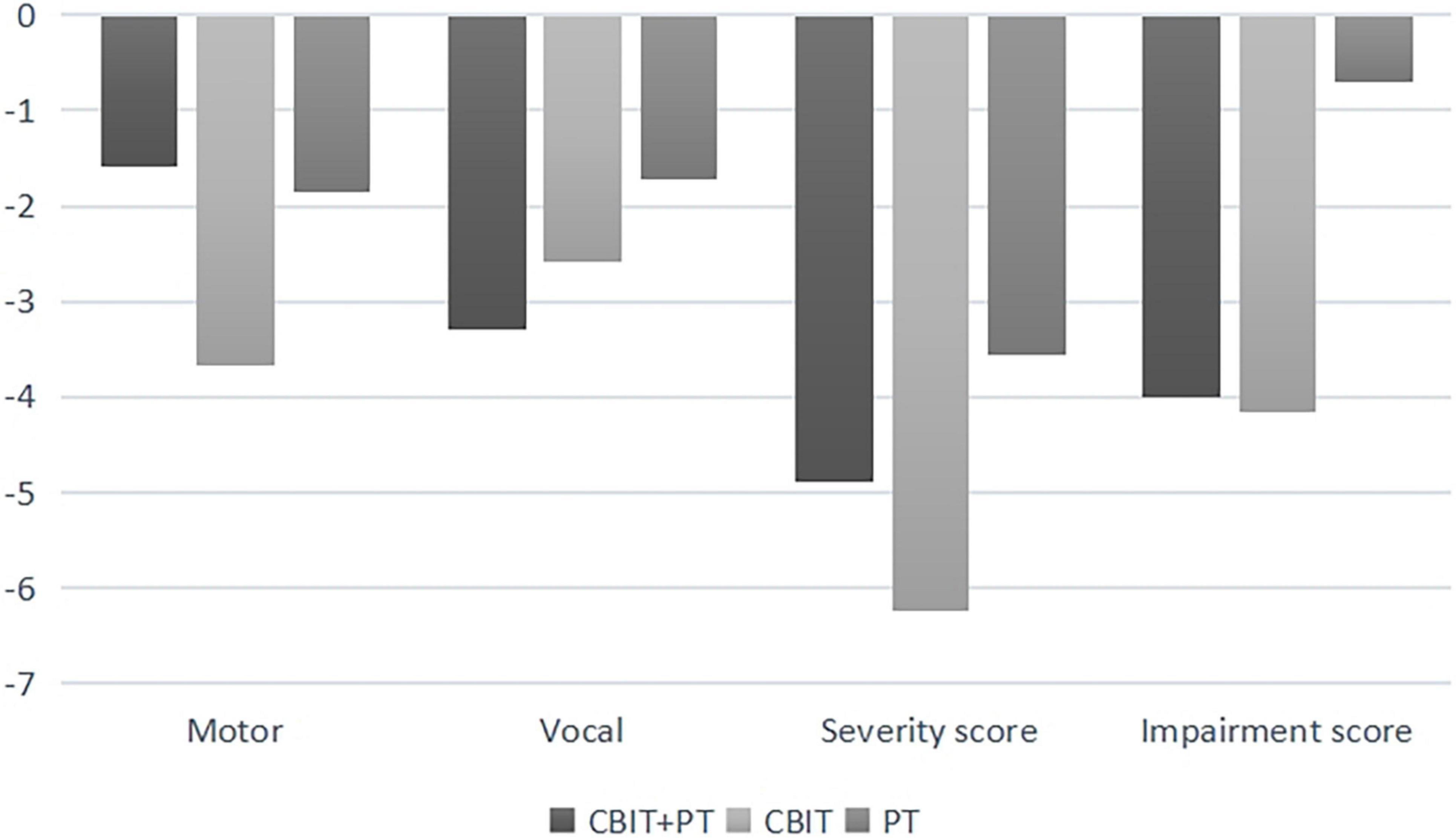
Figure 2. Yale global tic severity scale score variations (means) from baseline (T0) to time 1 (Tl).
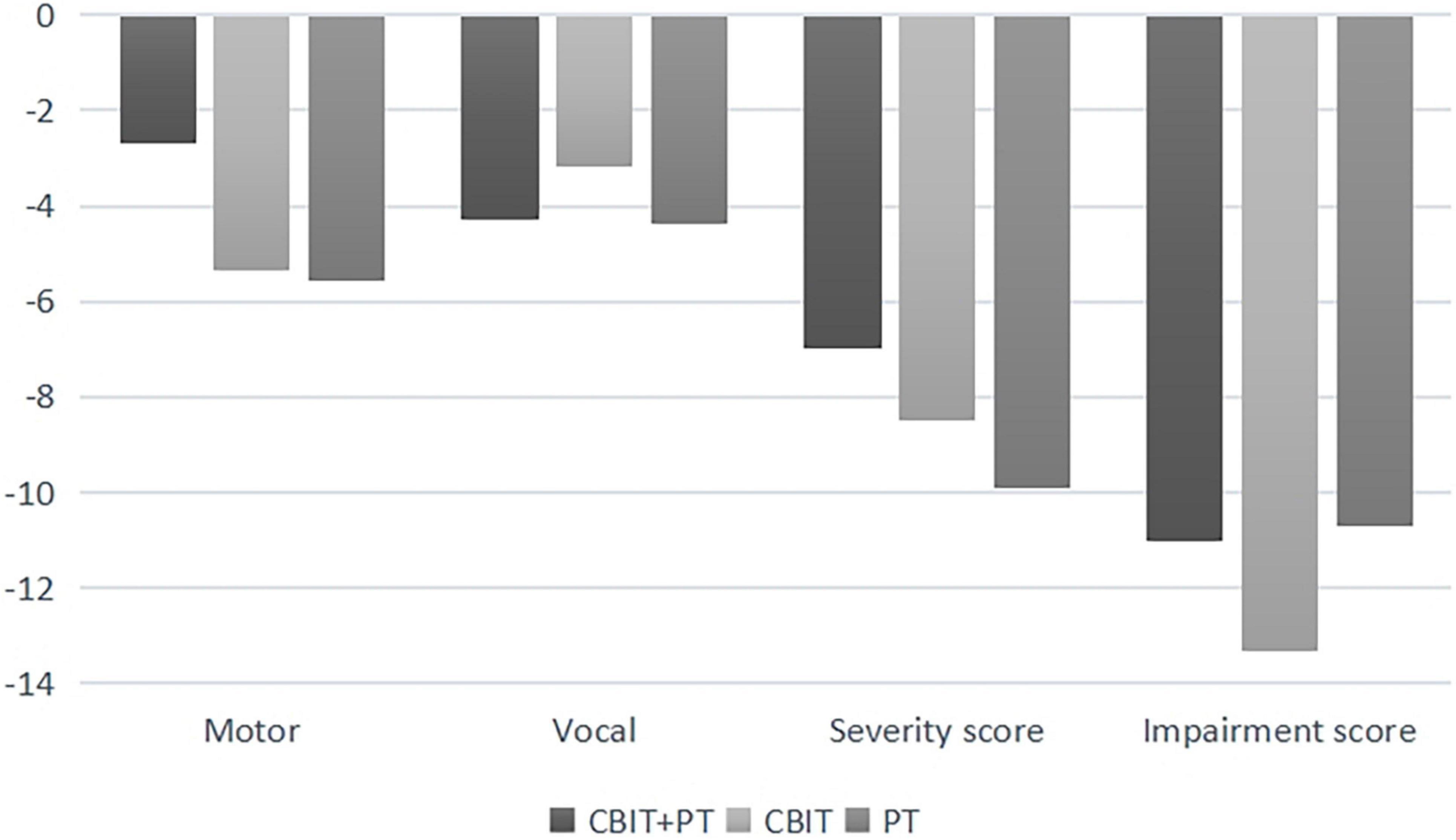
Figure 3. Yale global tic severity scale score variations (means) from baseline (T0) to time 2 (T2).
Outcome indicator 2: Score of CGI-I scale
For CGI-I, the main effect of time-point was significant [F(1,34) = 13.87, p = 0.001, ηp2 = 0.29], the main effect of group was not significant [F(2,34) = 1.63, p = 0.21], and no significant interaction was found between time-point and group [F(2,34) = 1.3, p = 0.29] (see Table 2). Neither main effect nor interaction effect of time-point and group for clinical efficacy of clinical intervention showed significant when we control the age and baseline total score of YGTSS as covariates (see Supplementary Table 1).
Quality of life
Change of scores of PedQL4.0
The repeated measures ANOVA showed that significant interaction was found between the time-point and group in emotional functioning [F(2,29) = 4.39, p = 0.02, ηp2 = 0.23], psychosocial [F(2,29) = 5.93, p = 0.007, ηp2 = 0.29], and total QoL score [F(1,34) = 3.72, p = 0.04, ηp2 = 0.20] of PedsQL for children suggesting a significantly larger improvement in emotional functioning, psychosocial, and total life quality in the CBIT group for children self-report (see Table 3). The interaction between time-point and group in emotional functioning [F(2,26) = 5.89, p = 0.008, ηp2 = 0.31], psychosocial [F(2,26) = 4.88, p = 0.016, ηp2 = 0.27] and total QoL score [F(2,26) = 3.43, p = 0.048, ηp2 = 0.21] of PedsQL for children were still significant even if we control the age and baseline total score of YGTSS as covariates (see Supplementary Table 2).
The PedsQL for proxy showed a significant main effect of time-point in physical functioning [F(1,33) = 8.35, p = 0.01, ηp2 = 0.2], emotional functioning [F(1,33) = 10.75, p = 0.002, ηp2 = 0.25], psychosocial [F(1,34) = 11.38, p = 0.002, ηp2 = 0.26], and total QoL score [F(1,34) = 13.21, p = 0.001, ηp2 = 0.29]; the main effect of group and interaction between time-point and group for sub and the total score was not significant (p > 0.05) (see Table 4). The interaction between the time-point and group in emotional functioning [F(2,30) = 4.08, p = 0.03, ηp2 = 0.21] and total QoL score [F(2,30) = 3.51, p = 0.04, ηp2 = 0.15] of PedsQL for proxy were significant when control the age and baseline total score of YGTSS as covariates, suggesting a significantly larger improvement in emotional functioning and total life quality in the CBIT group for parents reported (see Supplementary Table 3).
Discussion
This study investigated the adaptability of CBIT for a Chinese population and found CBIT was probably effective in reducing tic severity, tic-related impairment, and proved to improve the quality of life in Chinese children and adolescents with TS or CTD. Results also showed that CBIT and PT might be equally effective in reducing tic severity as measured by YGTSS and CGI-I scores. The absolute decrease of 8.5 points (45% from baseline) on the YGTSS severity score in the CBIT group was the same as the decrease of 9.93 points (41%) caused by the effects of medications after 10 weeks of treatment (T2). This is consistent with previous studies on HRT (15), this study reported a decrease in YGTSS severity score of 7.4 points (37%) and 9.41 points (39%) after 10 weeks of treatment with HRT and medicine, respectively.
The current study, to our knowledge, is the first to compare the effectiveness of CBIT + PT combinations with CBIT alone or PT alone in a sample of TS and CTD children and adolescents. It is worth noting that we found CBIT + PT may not be more effective in reducing tic severity than CBIT or PT alone, with the absolute decrease of 7 points (29% from baseline) on the YGTSS severity score in the CBIT + PT group after 10 weeks of treatment. The results are similar to the previous study by O’Connor (25). This study compared the effect of the comprehensive behavioral intervention (CBT) with and without medication in a sample of TS and TD adults and found the scores decrease of 7.72 points (57% from baseline) and 5.58 points (57%) on the Tourette Syndrome Global Scale tics sub-scale after treatment in the CBT + PT group and CBT alone group, respectively, suggesting that equivalent improvement in clinical efficacy. Another study found participants showed tic reduction after CBIT treatment regardless of tic medication status in 9–69 years, including children and adults sample, compared to participants on CBIT + PT (the YGTSS total score decreased by 6.4 points, 25% from baseline), the treatment effect of CBIT alone was significantly larger in participants on no tic medication (the YGTSS total score decrease 7.3 points, 29% from baseline), the results showed PT for TS might not influence the treatment effects of CBIT (26). And in 4 weeks (T1), the CBIT alone group even showed a significantly larger reduction in tic severity than the PT group, it can be explained by the course of PT, at the beginning of PT for tic, the medicine starting from the minimum dose, slowly increase to target treatment dose, the course of PT dependent on the patient’s response to the medication, it may take 4 weeks or more to satisfy the patients, the results in T2 also proved the course of PT.
The present study was designed to investigate the life quality aspects of treatment response. Both CBIT alone and CBIT + PT groups showed improvement in QoL domains, especially in emotional functioning and psycho-social area. The CBIT + PT group also showed significant improvement in school functioning for children self-report. This is possible because both the CBIT and PT can significantly reduce tic severity, and the psychosocial education component in CBIT can reduce parents’ excessive attention to children’s tic symptoms and alleviate the anxiety of parents and children, the social support component and relaxation technique in CBIT can promote the relationship between parents and children, and also improve the child’s emotional regulation skills.
The PT alone group showed no significant improvement in QoL domains. The side effects of PT could account for the results, in the study, 12 of the 15 patients in the PT group reported the side effects of medicines, including drowsiness (7 cases), extrapyramidal side effects (3 cases), weight loss (1 case), and dry mouth (1 case), which may reduce the patient’s quality of life and subjective perception of satisfaction with drug treatment. In summary, our study suggests that compared to PT, CBIT appears to be superior with respect to improve psychosocial functioning and has few side effects. Nevertheless, for achieving higher psychosocial functioning, CBIT might be an effective alternative or adjunct treatment for individuals with TD, especially for those who are worried or afraid of the side effects of PT, or suffer from serious side effects of PT.
Patients in this study also completed a mid-treatment (four sessions using 4 weeks) assessment in addition to assessments conducted post-treatment. The Tukey test showed in 4 weeks, the CBIT group showed a significantly larger reduction in tic severity (the YGTSS severity score decreased 6.4 points, 33% from baseline). This suggests that a shorter course of CBIT (e.g., four individual sessions) can also produce benefits compared to a standard course (eight sessions) of CBIT. For patients who must travel long distances to receive care and for medical settings without enough qualified behavior therapists, reduced sessions might be more convenient and practical and thus patients and their families are likely to be more willing to complete and comply with treatment. Further research on this abbreviated format is warranted. Indeed, a modified four-session CBIT over 3 months study in 2020 has already shown the effects in decreased tic severity in 6–18 years children (the YGTSS severity score decrease by 8.95 points, 46% from baseline) (27), the research suggested that CBIT intervention session might be “dose-specific,” the more sessions the greater improvements.
Our study has a few limitations. First, within the CBIT group, the subjects in the CBIT group and CBIT + PT group were not completely randomized. Although we were testing the feasibility of CBIT, it did alter randomization into the CBIT groups. This likely resulted in baseline YGTSS differences among the groups. Although this difference in baseline severity was not statistically and there were no other statistically significant demographic differences between the groups, it is possible that the groups differed on some other unmeasured factor and that such a factor may have differentially impacted treatment outcomes by condition. Second, to our knowledge, this is the first study of CBIT in Chinese mainland, but our limited sample size limits our ability to confidently generalize our findings to the broader population of China. Future research should replicate and expand upon these findings in large multi-site studies. Finally, the rate of treatment dropouts and those lost to follow-up was high but consistent with a recent meta-analysis of cognitive behavioral therapy dropout, which showed that the rate of the dropout was up to 26.2% during treatment (28). Reasons for these higher non-completion rates are unclear but given that our patients were outpatients, time, and transportation difficulties for patients in other provinces and cities may have been a contributing factor. Likewise for the PT group, the side effects or fear of side effects from PT may have increased the non-completion rate. It suggests a need for preparatory strategies and careful selection and supplementation of treatment setting/delivery in future study.
Conclusion
This study highlights that CBIT is probably effective in reducing tic severity and improving the quality of life in Chinese children and adolescents with tic disorders. CBIT + PT was possibly not superior to CBIT alone in both reducing tic severity and improvement in QoL. CBIT alone showed advantages in improving quality of life over CBIT + PT and PT alone. CBIT might be provided as a first-line treatment in children and adolescents in Chinese mainland, especially, those patients with mild to moderate tic symptoms if available in the future.
Data availability statement
The raw data supporting the conclusions of this article will be made available by the authors, without undue reservation.
Ethics statement
The protocol was approved by the Ethic Committees of the Children’s Hospital of Fudan University (No. 2018-290). Written informed consent to participate in this study was provided by the participants’ legal guardian/next of kin.
Author contributions
WX contributed to the acquisition of data and drafted the manuscript. QD contributed to the statistical analysis and drafted the manuscript. YZ contributed to revise the manuscript. WJ contributed to the acquisition of data. JH contributed to recruiting the patients. JS made a substantial contribution to the conception of the work and revise the manuscript. All the authors read and approved the final version of the manuscript.
Funding
This work was supported by grants from the Important and Weak Key Discipline Construction Projects of Health System in Shanghai in 2019: Psychosomatic Medicine (2019ZB0203), the Natural Science Foundation of Shanghai (19ZR1406500), the Three-Year Action Plan from 2020 to 2022 for the Construction of Shanghai Public Health System (GWV-10.2-XD31), and the Clinical Science and Technology Innovation Projects of Shanghai Shenkang Hospital Development Center (SHDC12020126).
Acknowledgments
We are very grateful to Douglas W. Woods at Marquette University for his careful guidance in writing this manuscript and polishing the language.
Conflict of interest
The authors declare that the research was conducted in the absence of any commercial or financial relationships that could be construed as a potential conflict of interest.
Publisher’s note
All claims expressed in this article are solely those of the authors and do not necessarily represent those of their affiliated organizations, or those of the publisher, the editors and the reviewers. Any product that may be evaluated in this article, or claim that may be made by its manufacturer, is not guaranteed or endorsed by the publisher.
Supplementary material
The Supplementary Material for this article can be found online at: https://www.frontiersin.org/articles/10.3389/fpsyt.2022.997174/full#supplementary-material
References
1. American Psychiatric Association. The Fifth Edition of the diagnostic and statistical manual of mental disorders (DSM-5). Washington, DC: APA (2013). 947 p.
2. Andrén P, Jakubovski E, Murphy TL, Woitecki K, Tarnok Z, Zimmerman-Brenner S, et al. European clinical guidelines for Tourette syndrome and other tic disorders-version 2.0. Part II: Psychological interventions. Eur Child Adolesc Psychiatry. (2022) 31:403–23. doi: 10.1007/s00787-021-01845-z
3. Eapen V, Cavanna AE, Robertson MM. Comorbidities, social impact, and quality of life in tourette syndrome. Front Psychiatry. (2016) 7:97. doi: 10.3389/fpsyt.2016.00097
4. Vermilion J, Augustine E, Adams HR, Vierhile A, Lewin AB, Thatcher A, et al. Tic disorders are associated with lower child and parent quality of life and worse family functioning. Pediatr Neurol. (2020) 105:48–54. doi: 10.1016/j.pediatrneurol.2019.12.003
5. Gun SE, Kilincaslan A. Quality of life among children and adolescents with tourette disorder and comorbid ADHD: A clinical controlled study. J Atten Disord. (2019) 23:817–27. doi: 10.1177/1087054718772158
6. Roessner V, Plessen KJ, Rothenberger A, Ludolph AG, Rizzo R, Skov L, et al. European clinical guidelines for tourette syndrome and other tic disorders. Part II: Pharmacological treatment. Eur Child Adolesc Psychiatry. (2011) 20:173–96. doi: 10.1007/s00787-011-0163-7
7. Piacentini J, Woods DW, Scahill L, Wilhelm S, Peterson AL, Chang S, et al. Behavior therapy for children with tourette disorder a randomized controlled trial. JAMA. (2010) 303:1929–37. doi: 10.1001/jama.2010.607
8. Wilhelm S, Peterson AL, Piacentini J, Woods DW, Deckersbach T, Sukhodolsky DG, et al. Randomized trial of behavior therapy for adults with tourette syndrome. Arch Gen Psychiatry. (2012) 69:795–803. doi: 10.1001/archgenpsychiatry.2011.1528
9. Bennett SM, Capriotti M, Bauer C, Chang S, Keller AE, Walkup J, et al. Development and open trial of a psychosocial intervention for young children with chronic tics: The CBIT-JR study. Behav Ther. (2020) 51:659–69. doi: 10.1016/j.beth.2019.10.004
10. Pringsheim T, Okun MS, Muller-Vahl K, Martino D, Jankovic J, Cavanna AE, et al. Practice guideline recommendations summary: Treatment of tics in people with Tourette syndrome and chronic tic disorders. Neurology. (2019) 92:896–906. doi: 10.1212/WNL.0000000000007466
11. Woods DW. Managing tourette syndrome : A behavioral intervention for children and adults. New York, NY: Oxford University Press (2008).
12. Billnitzer A, Jankovic J. Current management of tics and tourette syndrome: Behavioral, pharmacologic, and surgical treatments. Neurotherapeutics. (2020) 17:1681–93. doi: 10.1007/s13311-020-00914-6
13. Yang C, Hao Z, Zhang L-L, Zhu C-R, Zhu P, Guo Q. Comparative efficacy and safety of antipsychotic drugs for tic disorders: A systematic review and bayesian network meta-analysis. Pharmacopsychiatry. (2019) 52:7–15. doi: 10.1055/s-0043-124872
14. Yu L, Li Y, Zhang J, Yan C, Wen F, Yan J, et al. The therapeutic effect of habit reversal training for Tourette syndrome: A meta-analysis of randomized control trials. Expert Rev Neurother. (2020) 20:1189–96.
15. Rizzo R, Pellico A, Silvestri PR, Chiarotti F, Cardona F. A randomized controlled trial comparing behavioral, educational, and pharmacological treatments in youths with chronic tic disorder or tourette syndrome. Front Psychiatry. (2018) 9:100. doi: 10.3389/fpsyt.2018.00100
16. The Neurology Group of Chinese Pediatric Society, Chinese Medical Association. Expert consensus on the diagnosis and treatment of tic disorders in children. Chin J Pract Pediatr. (2017) 32:1137–40.
17. Chen JP, Yuan HC, Huang GQ, Lu YL. Study on habit reversal training in treatment of tic disorder. Chin Med Pharm. (2016) 6:25–8.
18. Haas M, Jakubovski E, Fremer C, Dietrich A, Hoekstra PJ, Jager B, et al. Yale global tic severity scale (YGTSS): Psychometric quality of the gold standard for tic assessment based on the large-scale EMTICS study. Front Psychiatry. (2021) 12:626459. doi: 10.3389/fpsyt.2021.626459
19. Faul F, Erdfelder E, Buchner A, Lang A-G. Statistical power analyses using G* Power 3.1: Tests for correlation and regression analyses. Behav Res Methods. (2009) 41:1149–60. doi: 10.3758/BRM.41.4.1149
20. Cohen J. Statistical power analysis for the behavioral sciences. Burlington: Elsevier Science (2013).
21. Sheehan DV, Sheehan KH, Shytle RD, Janavs J, Bannon Y, Rogers JE, et al. Reliability and validity of the mini international neuropsychiatric interview for children and adolescents (MINI-KID). J Clin Psychiatry. (2010) 71:313–26. doi: 10.4088/JCP.09m05305whi
22. Gau SS, Shang CY, Liu SK, Lin CH, Swanson JM, Liu YC, et al. Psychometric properties of the Chinese version of the Swanson, Nolan, and Pelham, version IV scale – parent form. Int J Methods Psychiatr Res. (2008) 17:35–44. doi: 10.1002/mpr.237
23. Guy W. ECDEU assessment manual for psychopharmacology. Rockville, MD: U.S. Department of Health, Education, and Welfare (1976).
24. Varni JW, Limbers CA. The pediatric quality of life inventory: Measuring pediatric health-related quality of life from the perspective of children and their parents. Pediatr Clin North Am. (2009) 56:843–63. doi: 10.1016/j.pcl.2009.05.016
25. O’Connor KP, Laverdure A, Taillon A, Stip E, Borgeat F, Lavoie M. Cognitive behavioral management of tourette’s syndrome and chronic tic disorder in medicated and unmedicated samples. Behav Res Ther. (2009) 47:1090–5. doi: 10.1016/j.brat.2009.07.021
26. Sukhodolsky DG, Woods DW, Piacentini J, Wilhelm S, Peterson AL, Katsovich L, et al. Moderators and predictors of response to behavior therapy for tics in tourette syndrome. Neurology. (2017) 88:1029–36. doi: 10.1212/WNL.0000000000003710
27. Chen, CW, Wang HS, Chang HJ, Hsueh CW. Effectiveness of a modified comprehensive behavioral intervention for tics for children and adolescents with tourette’s syndrome: A randomized controlled trial. J Adv Nurs. (2020) 76:903–15.
Keywords: Tourette syndrome, comprehensive behavioral intervention for tics (CBIT), chronic tic disorders (CTD), pharmacological treatment, life quality
Citation: Xu W, Ding Q, Zhao Y, Jiang W, Han J and Sun J (2022) A preliminary study of comprehensive behavioral intervention for tics in Chinese children with chronic tic disorder or Tourette syndrome. Front. Psychiatry 13:997174. doi: 10.3389/fpsyt.2022.997174
Received: 18 July 2022; Accepted: 14 October 2022;
Published: 11 November 2022.
Edited by:
Ayhan Bilgiç, İretnik Tzmir University of Economics, TurkeyReviewed by:
Serhat Turkoglu, Selçuk University, TurkeyÇağla Çelikkol Sadıç, Afyon Kocatepe University, Turkey
Copyright © 2022 Xu, Ding, Zhao, Jiang, Han and Sun. This is an open-access article distributed under the terms of the Creative Commons Attribution License (CC BY). The use, distribution or reproduction in other forums is permitted, provided the original author(s) and the copyright owner(s) are credited and that the original publication in this journal is cited, in accordance with accepted academic practice. No use, distribution or reproduction is permitted which does not comply with these terms.
*Correspondence: Jinhua Sun, MjAwNXN1bmppbmh1YUAxNjMuY29t
†These authors have contributed equally to this work
 Wen Xu
Wen Xu Qiang Ding
Qiang Ding Ying Zhao
Ying Zhao Wenqing Jiang2
Wenqing Jiang2 Jinhua Sun
Jinhua Sun